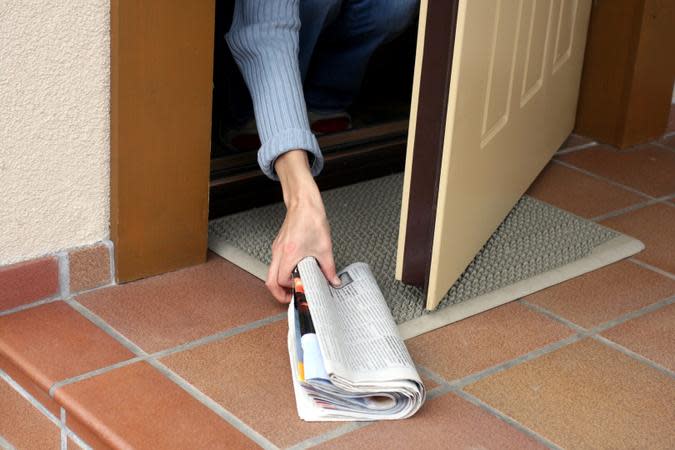Cutting Out These 24 Expenses Will Save You Over $15,000 a Year

When it comes to living expenses, the truth is that most Americans subsist on a very thin margin, even if their earnings are solid. A recent survey from LendingClub and PYMTS revealed that about 51% of Americans who earn over $100,000, are living paycheck to paycheck.
See: 8 Ways You’re Wasting Money at the Grocery Store
Next: How To Get Cash Back on Your Everyday Purchases
The good news is that if you take a closer look at how you live, you’ll likely find many areas where you can trim expenses and give yourself an extra buffer.
See what expenses you could cut from your budget, how you can save thousands of dollars in the process and how you can better invest the money instead.

1. Credit Card Interest
Monthly Savings: $64.47
Annual Savings: $773.61
Every month that you don’t pay your full credit card balance you’ll be charged interest. That’s essentially money you’re throwing away. The average American has a monthly credit card balance of $7,279, according to a recent report from LendingTree. With an average annual percentage rate of 19.07%, many Americans can save big on fees by getting rid of their credit card debt.
Let’s assume you’ve built up the average amount of credit card debt and want to pay it off over the course of a year. By the end of that year, you’ll have paid $773.61 in interest, according to Credit Karma’s debt repayment calculator.
Find: 10 Costco Meals That Are Cheaper Than Buying Takeout
Learn: Don’t Shop at Walmart on This Day of the Week

2. Life Insurance
Monthly Savings: $33
Annual Savings: $430
Life insurance is an essential benefit for many because it provides protection for spouses and heirs in case the primary breadwinner dies unexpectedly. This can be especially important if the family has a mortgage or other debts to pay off. The annual premium for a healthy 35-year-old male for a $500,000, 20-year term policy is about $430, according to CNN.
But if you have no dependents, you likely don’t need life insurance and might consider canceling your policy. Another option is to look for a job with employer-paid life insurance.
Also: 8 Frugal Habits of the Past To Save Money Today

3. Brokerage Commissions and Fees
Monthly Savings: $54.95
Annual Savings: $659.40
A few traditional, full-service brokerage firms still charge potentially hundreds of dollars per trade, depending on the size and type of investment. At Edward Jones, for example, commissions can run as high as 2.5% of the principal amount invested or a minimum of $50, plus a $4.95 transaction fee. Investing $2,000 every month means spending at least $54.95 on fees. Mutual funds can cost even more.
Many well-known, reliable discount brokers like Fidelity still have brick-and-mortar branches but offer $0 commission trades on stocks and no-load mutual funds.
Also, don’t overlook annual expense ratios when buying investments like exchange-traded funds. According to the Financial Industry Regulatory Authority’s fund screener, expense ratios for S&P 500 index funds range from 0% to 2.50%.

4. Bank Fees
Monthly Savings: $14.50 ($12 checking plus one out-of-network $2.50 ATM fee)
Annual Savings: $174
Some banks charge $12 or more per month to maintain a checking or savings account unless you meet certain criteria, such as a minimum daily balance. But many online banks offer these accounts for free. If you prefer not to bank online, check out your local credit union, which might offer free accounts and free ATM access.

5. Premium Gas
Monthly Savings: $33.75
Annual Savings: $405
Unless your car specifically requires premium gasoline, you don’t need to buy it. According to AAA, the price difference between premium and regular gasoline averages 75 cents per gallon. With the average American vehicle getting roughly 25 miles per gallon and the average American driving about 13,500 miles per year, sticking with regular gas can result in some real savings.

6. High-End Coffee
Monthly Savings: $58.50
Annual Savings: $702
Face it: Some people need their morning coffee to function normally. But even if that applies to you, coffee doesn’t have to cost a fortune. You don’t even have to cut coffee out of your life completely — just reconsider if the price you’re paying now is worth it. For example, a tall (small) brewed coffee at Starbucks is $2.95, but you can go to McDonald’s down the block and get a small cup for just $1. Assuming you buy a cup every day, that switch will save you $58.50 a month. You might even end up preferring the taste of McDonald’s coffee, making it a win-win.
Discover: 3 Things You Must Do When Your Savings Reach $50,000

7. Bottled Water
Monthly Savings: $4.68
Annual Savings: $56.26
Annual consumption of bottled water in the U.S. reached 47 gallons per capita in 2021, according to Supermarket News, which is a lot more expensive than drinking regular tap water. At an average cost of $1.20 per gallon of bottled water versus a typical $0.003 per gallon for municipal tap water, for example, you’re paying 400 times more for the bottled variety. Prices for different bottle sizes can be even higher.

8. Cable TV
Monthly Savings: $217
Annual Savings: $2,604
Cable television has grown from a minor utility into an expensive mishmash of multilevel packages with premium channels and content. Premium cable TV packages can cost about $217 a month, according to data compiled by Allconnect. Cutting the cord will save you money, especially if you use an antenna to pick up broadcast signals for free rather than sign up for a lot of streaming services to replace cable.

9. Streaming Services
Monthly Savings: $104.97
Annual Savings: $1259.64
See, streaming costs do add up. Services like Netflix and Hulu might seem like a dream come true because they’re much cheaper than cable TV packages, but they still cost something. Netflix Premium charges $19.99 per month, Hulu with Live TV costs $69.99 per month and Amazon Prime Video is included in the $14.99 per month fee for a Prime membership. If you bundle everything together, you end up paying a lot every year for these seemingly inexpensive services. Can you imagine cutting the cord completely? You’d certainly save a lot.

10. Phone Games
Monthly Savings: $26.38
Annual Savings: $316.56
Many smartphone users fall into the trap of playing online or app-based games that entice them with in-game purchases. In fact, the average monthly spend on mobile games reached $26.38 for existing users in 2021, according to Statista. The $26.38 monthly cost might not seem like much, but it adds up over time.
Find Out: Which Bank Gives 6% Interest on Savings Accounts?

11. Newspaper Subscriptions
Monthly Savings: $23
Annual Savings: $276
Nowadays, you can get news from any number of sources — often for free. Newspapers offer in-home delivery, but with newspaper subscriptions costing roughly $10 per month for a local paper to $40 per month for a national one like The New York Times, those fees add up. Switching to digital editions can save you money. A digital-only New York Times subscription, for example, is just $17 a month.

12. Out-of-Town Weddings
Annual Savings: $840 (one out-of-town wedding per year)
Attending an out-of-town wedding is no small endeavor. You must arrange travel, perhaps buy yourself a new outfit or two, purchase a wedding gift and find accommodations. Before you know it, you’ve blown a lot of money to see two people get hitched — $1,320 per guest flying to attend an out-of-town wedding, on average, according to WeddingWire.
Compare that to the $480 an average guest spends to attend a wedding in their own hometown. Declining just one out-of-town wedding invite per year can save you enough for a long weekend getaway of your own.

13. Magazines
Monthly Savings: $5.82
Annual Savings: $69.84
There’s nothing like the feel and smell of a glossy magazine in your hands. But buying them at the supermarket check out can cost a bundle. Consider subscribing instead. Forbes, for example, costs $9.99 per issue on the newsstand, but subscribing gets you eight issues per year, delivered to your home, for $49.99.

14. Satellite Radio
Monthly Savings: $18.99
Annual Savings: $227.88
Satellite radio lets you listen to hundreds of channels in your car and online. The industry is known for promotional pricing, but the regular cost of a satellite radio subscription can be hefty — $18.99 per month for the Sirius XM Music & Entertainment subscription, for example. With other low-cost or free options like Spotify and Pandora available, you can save cash and still access the music you want.
More: 5 Frugal Habits of Mark Zuckerberg

15. Warehouse Club Memberships
Annual Savings: $60
Shopping at warehouse clubs is popular for budget-conscious families. But if you don’t have the storage space or the inclination to buy in bulk on a regular basis, your membership could wind up costing more than it’s worth. A Costco membership costs $60 a year, and a Sam’s Club membership is $50. Shop during sales at other grocery stores and save on the membership fees.

16. Gym Memberships
Monthly Savings: $60
Annual Savings: $720
A typical higher-end gym membership can cost around $60 per month, but many people with gym memberships never use them. If you’re among that percentage — and even if you’re not — dropping your gym membership can add up to big savings.

17. Cigarettes
Weekly Savings: $56 (one pack per day)
Monthly Savings: $224
Annual Savings: $2,688
Smoking rates continue to decline in the U.S., with only 12.5% of American adults smoking, according to the Centers for Disease Control and Prevention. If you still light up regularly, here’s another reason to quit: You’ll save an average of $8 per pack.

18. Manicures and Pedicures
Monthly Savings: $55
Annual Savings: $660
While it’s fun to treat your fingers and toes to a little upgrade every now and then, those services can add up. The average manicure is about $25 a pop, according to StyleSeat, while the average pedicure runs around $30. Doing your nails at home can save you quite a lot of money over the course of a year, even if you only get one mani/pedi a month.
I Grew Up Poor: Here Are 8 Things I Never Waste Money On

19. Haircuts
Monthly Savings: $8.83
Annual Savings: $106
The national average cost of a haircut is $53, according to a survey by You Probably Need a Haircut. Let’s say you get your hair cut once every six weeks, for about eight haircuts a year. If you can stand a little shag, let your hair grow longer, get a haircut every two months and watch your bank account get bigger.

20. Lunch Out
Monthly Savings: $200 (for 20 lunches out)
Annual Savings: $2,400
Lunch costs range from a few dollars at a fast-food restaurant to $20 at a nice sit-down place. Let’s assume you’re spending $10 total (including tax and tip) on lunch each day. For that much money, you could probably buy the supplies to make a humble lunch for the whole week. If you saved the money you used to spend on eating out for lunch, you could afford a vacation by the end of that year.

21. Takeout Food and Eating Out
Monthly Savings: $240
Annual Savings: $3,030
When you eat out or order takeout food instead of making it yourself, your wallet can take a big hit. The average American spends almost $60 a week on “away from home” food, according to the U.S. Bureau of Labor Statistics. By making food at home rather than going out or ordering in, you could save a significant chunk of change that could be spent on other necessities.

22. Ride-Sharing Services
Monthly Savings: $140 (one ride per week)
Annual Savings: $1,680
The two most popular ride-sharing services, Uber and Lyft, have seen significantly higher fares in the past couple of years due to increased demand, driver shortages and fuel surcharges. The typical Lyft ride costs about $35, according to Ridester — a chunk of which you likely can save by walking or taking public transportation.
Costco Will Give You Free Groceries in Exchange for Old Electronics; Here’s How To Take Advantage

23. Dry Cleaning
Monthly Savings: $15
Annual Savings: $180
Dry cleaning services typically charge by the item, so prices vary depending upon which items are brought in for cleaning. Many people reserve this service for hard-to-wash things like suits, slacks and dresses. The cost to dry clean a suit once a month typically runs around $20, while dresses can run around $15. Figuring a monthly spend of $15, if you can handle the work yourself, you could save almost $200 dollar a year.

24. Online Shopping Shipping
Monthly Savings: $10
Annual Savings: $120
Although many online retailers offer free shipping, some stores charge a fee for orders under a certain dollar value. At Bloomingdale’s, for example, shipping is free with purchases greater than $150. A purchase total between $50 and $75 incurs a $10 shipping fee. Those fees can really add up, even if you only shop once a month.
If you completely eliminate the prior 24 things from your budget, you stand to save over $20,000 every year. Granted, that’s probably impractical, but this exercise does show that the little things add up. Do a spending audit, and then prioritize your expenses. Cut out what doesn’t matter to you so you have more money for the things that do.
Daria Uhlig contributed to the reporting for this article.
More From GOBankingRates
Robert Kiyosaki Shares 7 Steps To Reach Your Financial Goals
This Mistake Can Tank Your Credit Score 100 Points Overnight
This article originally appeared on GOBankingRates.com: Cutting Out These 24 Expenses Will Save You Over $15,000 a Year
